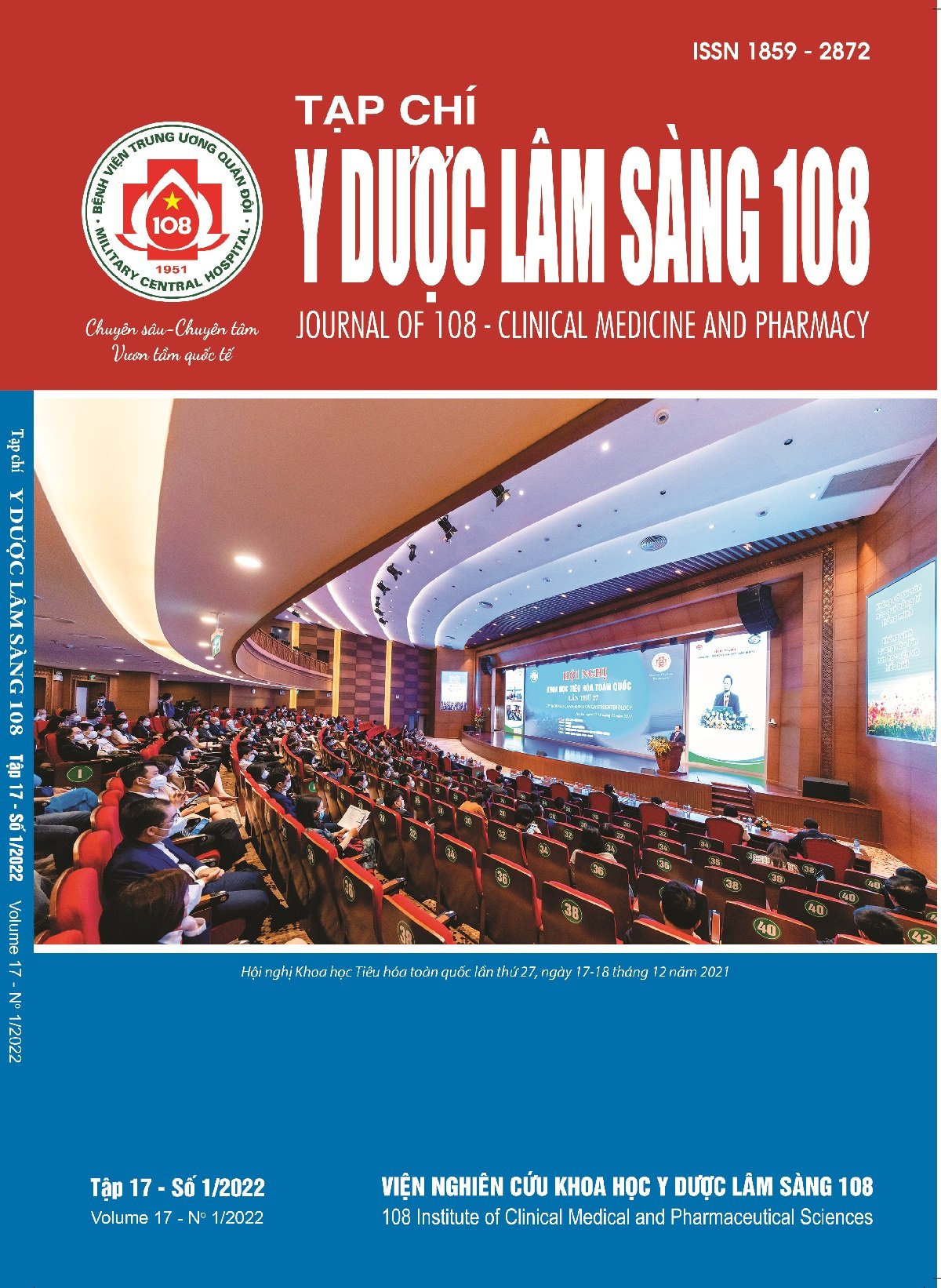Tỷ lệ và các kiểu đột biến gen IL36RN và CARD14 ở bệnh nhân vảy nến thể mủ ở Việt Nam
Main Article Content
Keywords
Tóm tắt
Mục tiêu: Xác định tỷ lệ và các kiểu đột biến gen IL36RN và CARD14 ở bệnh nhân vảy nến thể mủ ở Việt Nam. Đối tượng và phương pháp: Nghiên cứu cắt ngang mô tả trên 64 bệnh nhân vảy nến mủ tại Bệnh viện Da liễu Trung ương và Bệnh viện Da liễu Thành phố Hồ Chí Minh. Các bệnh nhân sẽ được lấy mẫu máu (2ml) và tiến hành giải trình tự xác định các đột biến trên gen IL36RN và CARD14 tại Trung tâm Y sinh học phân tử, Đại học Y Dược Thành phố Hồ Chí Minh. Kết quả: Tỷ lệ đột biến gen IL36RN và CARD14 ở bệnh nhân vảy nến thể mủ ở Việt Nam lần lượt là 50% và 78,1%. Tỷ lệ đột biến gen IL36RN đơn thuần là 15,62%, đột biến CARD14 đơn thuần là 43,75%, và có 34,38% bệnh nhân mang cả 2 loại đột biến nói trên. Ở gen IL36RN, các kiểu đột biến thường gặp là c.115+6T>C (32,8%) và c.227C>T (17,2%). Đáng chú ý kiểu đột biến c.227C>T luôn đi kèm với đột biến c.115+6T>C. Ở gen CARD14, các kiểu đột biến thường gặp là: c.1641C>T (39,1%), c.1753G>A (28,2%), c.2458C>T (64,1%). Kết luận: Các đột biến gen IL36RN và CARD14 chiếm tỉ lệ khá cao trong các trường hợp vảy nến mủ ở Việt Nam.
Article Details
Các tài liệu tham khảo
2. Ellingford J, Black G, Clayton T et al (2016) A novel mutation in IL 36 RN underpins childhood pustular dermatosis. Journal of the European Academy of Dermatology and Venereology 30(2): 302-305.
3. Fuchs-Telem D, Sarig O, van Steensel MA et al (2012) Familial pityriasis rubra pilaris is caused by mutations in CARD14. Am J Hum Genet 91(1): 163-70.
4. Fujita H, Terui T, Hayama K et al (2018) Japanese guidelines for the management and treatment of generalized pustular psoriasis: The new pathogenesis and treatment of GPP. J Dermatol 45(11): 1235-1270.
5. Hayashi M, Nakayama T, Hirota T et al (2014) Novel IL36RN gene mutation revealed by analysis of 8 Japanese patients with generalized pustular psoriasis. J Dermatol Sci 76(3): 267-269.
6. Jordan CT, Cao L, Roberson ED et al (2012) PSORS2 is due to mutations in CARD14. The American Journal of Human Genetics 90(5): 784-795.
7. Kanazawa N, Nakamura T, Mikita N et al (2013) Novel IL 36 RN mutation in a J apanese case of early onset generalized pustular psoriasis. The Journal of dermatology 40(9): 749-751.
8. Körber A, Mössner R, Renner R et al (2013) Mutations in IL36RN in patients with generalized pustular psoriasis. The Journal of investigative dermatology 133(11): 2634.
9. Li M, Han J, Lu Z et al (2013) Prevalent and rare mutations in IL-36RN gene in Chinese patients with generalized pustular psoriasis and psoriasis vulgaris. The Journal of investigative dermatology 133(11): 2637.
10. Li M, Han J, Lu Z et al (2013) Prevalent and rare mutations in IL-36RN gene in Chinese patients with generalized pustular psoriasis and psoriasis vulgaris. J Invest Dermatol 133(11): 2637-2639.
11. Mulero JJ, Pace AM, Nelken ST et al (1999) IL1HY1: A novel interleukin-1 receptor antagonist gene. Biochemical and biophysical research communications 263(3): 702-706.
12. Navarini AA, Burden AD, Capon F et al (2017) European consensus statement on phenotypes of pustular psoriasis. J Eur Acad Dermatol Venereol 31(11): 1792-1799.
13. Qin P, Zhang Q, Chen M et al (2014) Variant analysis of CARD14 in a Chinese Han population with psoriasis vulgaris and generalized pustular psoriasis. J Invest Dermatol 134(12): 2994-2996.
14. Setta-Kaffetzi N, Navarini AA, Patel VM et al (2013) Rare pathogenic variants in IL36RN underlie a spectrum of psoriasis-associated pustular phenotypes. The Journal of investigative dermatology 133(5): 1366.
15. Sugiura K (2014) The genetic background of generalized pustular psoriasis: IL36RN mutations and CARD14 gain-of-function variants. Journal of dermatological science 74(3): 187-192.
16. Sugiura K, Muto M, Akiyama M (2014) CARD14 c.526G>C (p.Asp176His) is a significant risk factor for generalized pustular psoriasis with psoriasis vulgaris in the Japanese cohort. J Invest Dermatol 134(6): 1755-1757.
17. Sugiura K, Takemoto A, Yamaguchi M et al (2013) The majority of generalized pustular psoriasis without psoriasis vulgaris is caused by deficiency of interleukin-36 receptor antagonist. Journal of Investigative Dermatology 133(11): 2514-2521.
18. Tauber M, Bal E, Pei XY et al (2016) IL36RN mutations affect protein expression and function: A basis for genotype-phenotype correlation in pustular diseases. J Invest Dermatol 136(9): 1811-1819.
 ISSN: 1859 - 2872
ISSN: 1859 - 2872
